|
|
|
|
Products mentioned in this Article
--None--
|
|
|
|
|
|
|
|
|
 |
|
|
|
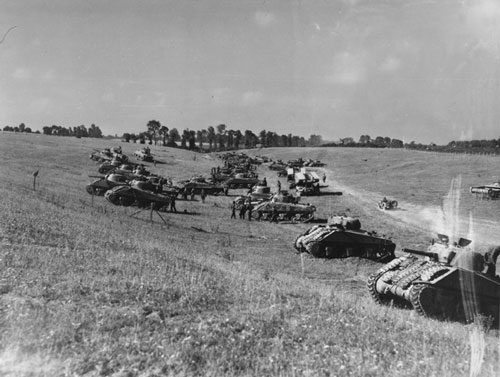
Tank concentration of the Fort Garry Horse ready to leave for
noon attack from
Bretteville-Le-Rabet, Normandy, during Operation
Tractable, 14 August 1944. Photo
by Donald I. Grant. Department of National Defence/National Archives of Canada,
PA-113658.
|
Blame Canada!
Operation Tractable: 14-21 August 1944
By Van Norton
Following days after Operation Totalize, the II Canadian Corp led by Lt. General Guy Simonds mounted another offensive with the goal of reaching Falaise. The American allies were pressing their sweeping breakthrough to the south and an opportunity existed to encircle the bulk of the German Seventh Army and Fifth Panzer Division in Normandy.
Simonds formed up his tanks into two columns to drive into the German positions. In one column was the 4th Canadian Armoured Division and the other was the Third Infantry Division and the 2nd Armoured Brigade.
|
The RAF would bomb along either flank of the column and smoke screens would be laid to allow the armour to advance in relative safety. Coordination with Allied bombers was again poor and yellow signals indicating friendly troops were thought to be enemy positions. Several crews dropped their payloads in the Canadian and Polish rear area killing 165 men. Even with this misfortune, the columns moved out and began to push through the weakening German defensive positions.
|
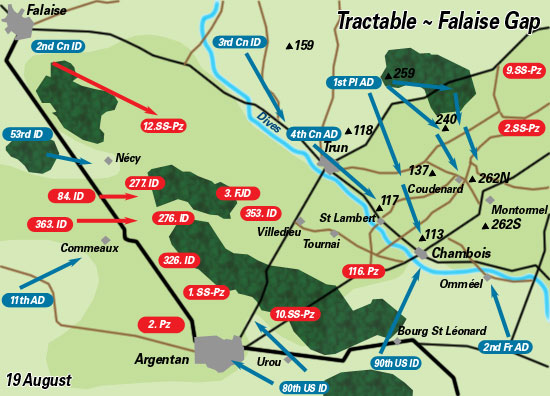 |
|
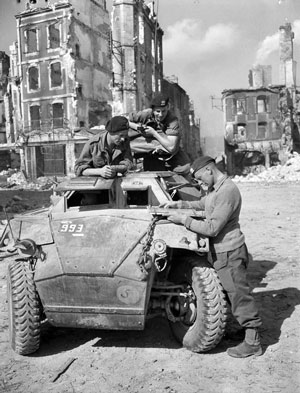
|
A counter-attack by Tigers of the 102. Schwere
SS-Panzerabteilung stalled the advance around 6 km from Falaise on the
evening of the 14 August.
On 15 August, Simonds was ordered to capture Falaise as soon as possible. The Second Canadian Division was given the mission to take the town. Defence in and around the area was intense with the division entering the town in the afternoon of 16 August. Even then, there was house-to-house fighting with some 60 Hitler Youth fighters having entrenched themselves in the École supérieure in the centre to town. It would be 18 August before the last German defenders in Falaise surrendered.
Without the hoped for encirclement, the German retreat began. The 4th Canadian Armoured Division’s new objective was the village of Trun. However, they ran into stiff resistance while trying to cross the Ante River. The Germans occupied a nearby hill and using heavy mortars and machineguns hotly contested the river crossing. In the afternoon of 17 August, the 4th succeeded in crossing the river and continued on toward Trun.
Left: The driver of a Humber I scout car receiving orders, Falaise, France, 17 August 1944. Library and Archives Canada - Copy negative: PA-138494.
|
The 1st Polish Armoured Division was also ordered to the south east to block the German retreat. Elements of the 1st Polish Armoured Division broke through toward Chambois. The tactical group Koszutski (2nd Armoured Regiment and 8th Rifle Battalion) tried to make its way in the darkness of the night of 17/18 August to Chambois. However their guide misunderstood their request and led them to Champeaux. Champeaux was the current headquarters of the 2. SS-Panzerdivision and a vicious fight developed.
|
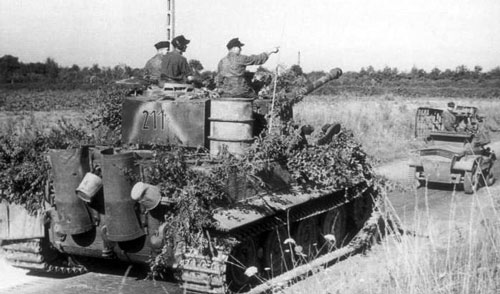
|
|
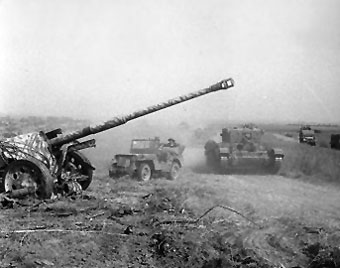
|
Only a strong counter-attack by the 8th Rifles
allowed the Poles to disengage around noon. Lt. General Maczek ordered
the Koszutski group and other units from the 1st Polish Armoured
Division to link up at Hill 262, which they called Maczuga (The Mace)
because of its shape.
After capturing Trun on the morning of 18 August, the 4th Canadian Armoured Division dispatched a column consisting of the South Alberta Regiment and Argyll and Sutherland Highlanders of Canada, under command of Major D.V. Currie, with the mission to seize the bridge of Saint-Lambert and establish contact with the Americans to the south. This would deny the Germans the use of the last crossing points on the Dives River. The column encountered heavy anti-tank gun fire from the village of Saint-Lambert and after losing two tanks, fell back to a defensive position on Hill 117.
|
|
On the morning of 19 August, Currie resumed his attack. He approached within 1000m of the Dives before being forced to halt again. The encirclement had funnelled extremely large numbers of German troops into the Saint-Lambert area. Currie had to request Allied artillery to target his position to dislodge German infantry climbing on his tanks. Later in the day the tanks were using their machine-guns on each other to prevent Germans from attaching explosives to the tanks.
The Poles meanwhile took Hill 262 on 19 August. This placed the Polish troops of the 1st Armoured Regiment, 8th, 9th, and Podhale Rifle Battalions in a river of retreating German forces. A supply convoy was ambushed trying to reach them and it became clear that the 2000 Poles were now squarely in the way of about 100,000 retreating Germans.
|
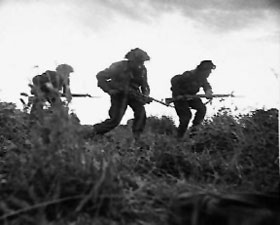
|
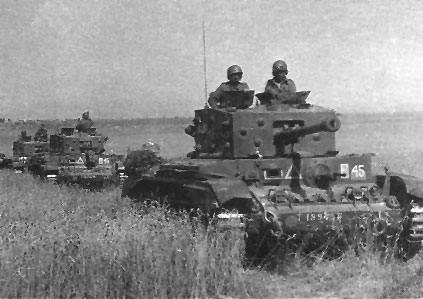 |
Before dawn on 20 August German attacks began on Hill 262. The 8. Panzergrenadier Regiment (Der Furher) of the 2nd SS Panzerdivision (Das Riech) attacked at 8am from outside the pocket. The 9. SS-Panzerdivision “Hohenstauffen” held the right flank of German attack by blocking advanced units of 4th Canadian Armoured Division on hill 240. A single Panther appeared on Hill 239 and surprising the defenders and destroyed 5 Shermans within 2 minutes. The 3. Fallschirmjägerdivision then began their attack from inside the pocket. Attacks continued throughout the day and into the night as the Polish defenders exhausted their ammunition. An airdrop to re-supply the Poles missed its target and fell mostly on the Canadian troops near Hill 240.
|
|
At midday on 21 August the first units of the
22nd Canadian Armoured Regiment broke through to the Poles.
|
|
By this
point, of the original 2000 men, there were 4 officers and less than
100 men still combat ready. Out of 87 tanks, less than 30 were still
operations.
"No
1 squadron's co-axial machine-guns fired almost continually from
leaving 239 until arriving at 262 and the results were devastating. All
the Germans in the area were either killed or ran away… The picture at
262 was the grimmest the regiment has so far come up against..."
- 22nd Canadian Armoured Regiment (Canadian Grenadier Guards), War Diary, 17-21 August 1944
|
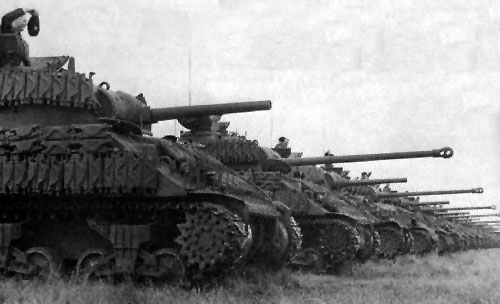 |
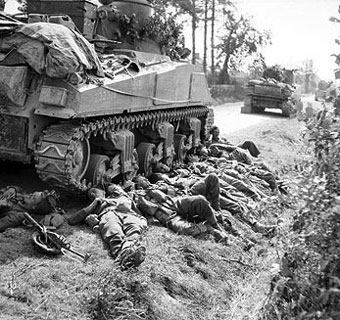 |
By the end of 21 August the Falaise pocket was closed. The delays in the link up between American and Commonwealth forces had allowed thousands of German soldiers to escape. However, the Germans lost a major portion of their heavy armament. More than 200 tanks, nearly 1000 guns, and over 5000 other vehicles were captured or destroyed. This was the final major battle in the liberation of Normandy from the Reich and was end of the German 7th Army.
|
Last Updated On Monday, March 10, 2008 by Wayne at Battlefront
|
|
|